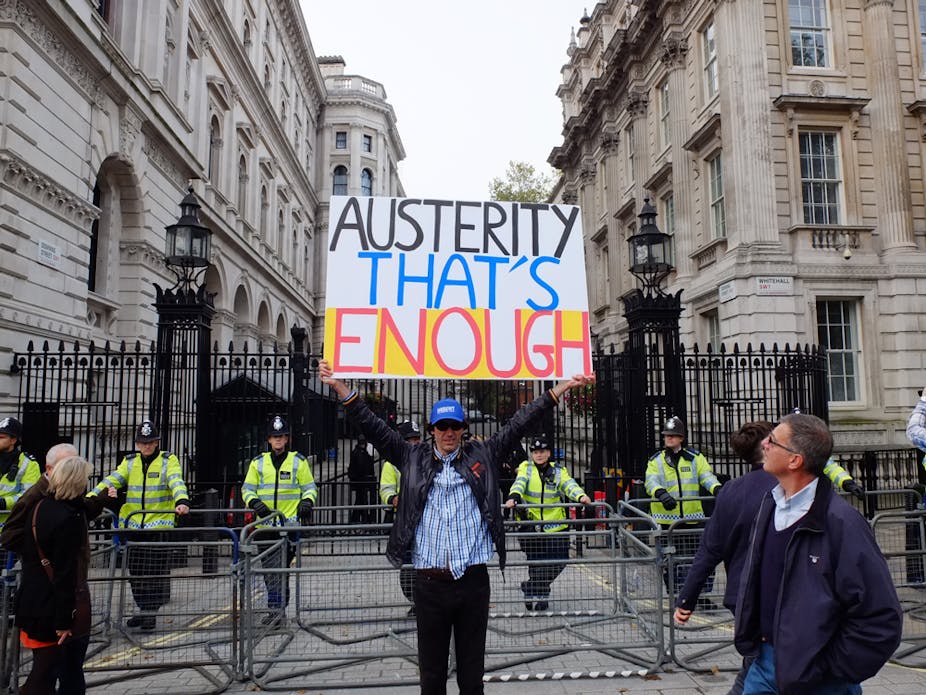Liberal Democrat minister Danny Alexander has brought benefits back into the election campaign by revealing that the Conservatives plan to make £8bn in immediate cuts to the welfare budget, including slashing child benefits and family support.
This comes as pressure mounts on the Tories to answer questions about how they plan to remove £12bn from the welfare budget by 2017-18.
In recent years, successive governments have focused on the needs of older people and cut benefits for those of working age. For a long time, the public has generally shown support for this approach. But as the cuts begin to bite, the tide of opinion appears to be shifting. The next government may find itself up against greater opposition if it tries to trim the welfare budget back even further.
The bill
Pensions alone currently cost nearly 6% of GDP and are expected to rise by about a fifth by 2044. But poverty among older people has been effectively addressed with real pension increases under the previous and current government. Pensioner poverty (after housing costs) fell from about 24% to 13% between 2002-3 and 2012-13. Everyone loves pensioners and those of us who aren’t one yet hope to become one in the future.
In contrast, poverty among working-age adults with children rose slightly from 24% to 25% over the same period. For those without children, poverty increased from about 16% to about 20%.
This has been put down to the combination of real wage falls, greater job insecurity and the harsh cuts to housing benefit, job-seeker’s allowance, tax credit and other benefits that have taken place since 2010. It is worth noting, though, that the living standards of the working-age poor, even those with children, only just kept pace with wage increases in the good times before the 2008 recession.
An election issue
It’s not yet clear whether the Conservative Party will reveal the detail of its cuts plan. It didn’t feature in the party’s election manifesto but the Lib Dems are bound to keep up the pressure in the final week of campaigning. Labour’s programme is more moderate but it does not restore the cuts of the past five years. No one, it seems, loves the working-age poor.
Both parties may be mistaken if they think such a harsh approach will win support from voters. Despite years of benefits bashing, there are now indications that public attitudes are beginning to shift towards greater sympathy for the poor.
The most recent British Social Attitudes survey confirms this impression.
The percentage of people supporting higher taxes to pay for more healthcare, education and welfare fell steadily from 63% in 2001 to 31% in 2010. But numbers are increasing again, rising to 34% 2014.
This matters because greater sympathy from the public could translate into greater support for parties that oppose benefits cuts for the poor. It will also be harder for parties committed to cuts to achieve their public spending targets if public opinion will no longer accept low levels of welfare benefits.
The chart below shows how pensions have always received the highest level of support, while unemployed people and single parents have been at the bottom. Support for pensioners rose even higher from the mid 1990s to about 2005, while support for unemployed people fell even lower.

This trend went into reverse and the shift has grown more marked under the current government. Since 2010-11 the groups that have experienced the sharpest benefit cuts under the coalition (unemployed people, single parents, children) have moved up as priorities.
Disabled people, always relatively high in public sympathy, and affected by the introduction of Employment Support Allowance and particularly the Work Capability Test have also received more support since 2010.
Answers to a separate question show that the proportion who think benefits for the unemployed are too low and cause hardship had also fallen steadily from a high of 55% in 1993 to a low of 19% in 2011. But again, it is rising again and now stands at 28%.
Taken together, this all suggests that after a considerable period of of accepting a harsher benefits regime, the British public may have had enough.
Welfare and the vote
Further indications of a shift in attitudes are contained in the pattern of attitudes among voters for different parties. In 2014, 44% of Labour supporters agreed with spending more on welfare while only 17% of Conservative supporters said the same.
A similar gap had opened up between the two parties when it came to beliefs about unemployment benefits. Among Conservative supporters, 71% believed benefits for unemployed people are too high and discourage work. Among Labour supporters, only 38% took that stance. In both cases the party difference in 2014 is much wider than that in 2010.
The attitude survey evidence may reveal some public unease at policies that cut benefits for the poor of working age, in work and out of it, but is not yet sufficiently sustained to provide evidence of a decisive shift in attitudes.
There are, however, real signs that the pattern of the last few years of a withdrawal of public support for the welfare state for those of working age may be at last going into reverse. A shift in public attitudes here could well prompt a change in approach and should be taken into consideration by whichever party wins the May election.

